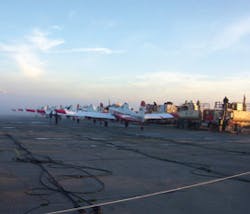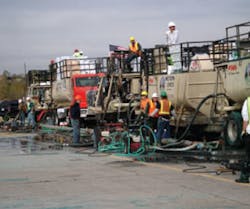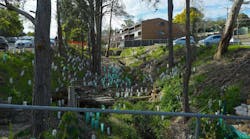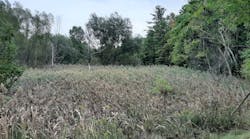Project Profile: Speedy Delivery
In a business world driven by healthy competition, it’s nice to hear the occasional report of companies coming together for the common good. In the case of an erosion control project in the aftermath of southern California wildfires near Corona, CA, in late October 2007, it was more than a feel-good story-it was an environmental necessity.
After the fires burned more than 28,000 acres of the Santiago Canyon, including 6,701 acres of the Cleveland National Forest, the US Forest Service determined that 1,241 acres of forestland had been severely damaged by high-intensity fire. With slopes at less than 50%, this acreage needed to be stabilized with hydromulch until the natural process of revegetation would eventually take over. This was necessary to reduce the immediate possibilities of soil erosion, mudslides, and flooding of the surrounding cities and homes.
The contract for restoration of the Santiago Fire area was awarded to Aero Tech Inc., a New Mexico-based contractor specializing in aviation services, including aerial hydromulching. But Aero Tech wasn’t going at this alone. The company partnered with Western States Reclamation Inc., an environmental contracting corporation with headquarters in Frederick, CO.
“We first teamed up with Aero Tech back in 2000,” says Colby Reid, reclamation division manager for Western States. “We’ve worked together on several projects since, and it’s been a very good relationship.”
Taking the large magnitude of the Santiago Fire job into account, Aero Tech and Western States brought in two additional companies to round out what has become sort of a four-member fire reclamation posse over the years. WildLands Inc., an environmental restoration company based in Richland, WA, and Erickson Air-Crane Incorporated of Central Point, OR, joined the team, and the race was on to restore the affected areas of the Santiago Canyon.
“The biggest challenge for any project is mobilization,” says Reid. “After a bid is accepted, you have to move quickly to find locations for planes and equipment, and to secure a water supply and materials.”
The timing of the job made acquiring materials more of a logistical challenge than usual. “When you have a job of this size, you need so much material that you’re basically draining the resources of the mulch industry,” says Adam McCullugh, project manager and estimator for WildLands. “On top of that, this project came about during the local fall seeding window, so distributors are already supplying contractors who are doing work that’s been planned out ahead of time. So we’re drawing resources from wherever we can get them. Some of the mulch even has to come from clear across the country.”
With approximately 40 workers and two staging areas with ample supplies and equipment in place-Western States and Aero Tech set up at Corona Municipal Airport, with WildLands and Erickson at a heli-base near Irvine Lake-the reclamation project officially began on December 17, 2007.
Aero Tech flew six Air Tractor AT-802 fixed-wing airplanes out of the airport operation, while Western States mixed hydromulch and loaded the planes using seven HydroSeeders from Finn Corporation, including two of the manufacturer’s new Titan 400 units. “We got the Titan HydroSeeders right before the job started,” says Reid. “We also had four Finn T-330s and one T-400 on this project. Our Finn machines have been very reliable over the years. They’re obviously well made because they hold together under some extreme conditions.”
Finn’s T-400 and T-330 are each powered by a 115-horsepower engine. The new Titan 400 features a 170-horsepower engine. “I was very interested in the increased productivity of the larger motor and the larger pump,” says Reid. “It’s a big help in getting material out faster. The larger volume is a big plus as well. Sometimes our sites are remote and a long way from water. Every extra bit of water and material you can haul saves time and cuts down on trips to and from the base.”
Western States used its HydroSeeders to produce a hydromulch mix of 60% wood and 40% paper with guar gum tackifier, a standard material combination for Forest Service projects. Although the material itself wasn’t anything out of the norm, the fast pace at which it had to be produced was significant. Western States had to run its machines nonstop with high volumes to keep getting planes reloaded as they returned.
“Each plane holds 800 gallons of material,” says Reid. “We pump directly out of the Finn equipment into the airplane. From the moment we’re hooked up to the aircraft, it takes about 40 to 60 seconds to load it up. It’s a very high-tempo operation, so the machines have to produce high volumes of material quickly-and they did!”
At the Irvine Lake site, Erickson flew an S-64 Aircrane Helitanker equipped with a 2,650-gallon firefighting tank. WildLands ran two Finn HydroSeeders of its own-a T-330 and a Titan 400, which WildLands had received two months earlier for a job in Los Angeles. Mulch was delivered from the Finn machines into a storage tank. A large 8-inch pump was then used to load from the tank to the helicopter.
“The helicopter was averaging anywhere from 10 to 15 minutes for turnaround time between reloads,” says McCullugh. “Once it landed and we were hooked up, we were loading 2,200 to 2,500 gallons of material into the helicopter in as little as 40 seconds.”
Keeping the storage tank full of enough material to fully load the helicopter required the HydroSeeders to run continuously. “Stopping or slowing down just aren’t options on a job like this,” says McCullugh. “We’re able to put a lot of material in the Finn machines. The Titan has a third agitator for mixing, and we can pump out some pretty thick slurries. The higher volume that the equipment can handle is very important-it allows us to get the job done quickly.”
Unfavorable weather conditions made speed and efficiency even more critical to the project’s success. The contractors had to wait out heavy rains, fog, and high winds on several occasions, so taking advantage of breaks in the weather pattern was an absolute must. “That’s the tricky thing about our industry,” says Reid. “Fire season comes right before the rainy season, so you’re always trying to get ahead of the weather. The faster you can get material out of the tanks and onto the ground, the better.”
The fact that the job fell over the Christmas and New Year’s Day holidays didn’t make things any easier, especially when it came to maintaining an adequate supply of material. But crews from all four companies were diligent in staying on task.
“We had guys working from daylight to dark every day of the week, nonstop right through the holidays,” says McCullugh. “It can be pretty brutal work at times, but we’ve got great people and everyone held up. We’re very proud of what we accomplished on this job.”
By the time the project was completed on January 21, 2008, the six Aero Tech planes and Erickson Helitanker had combined to put in well over 1,000 hours of flight time. In that time, the aircraft delivered 4.5 million gallons (or 1,200 tons) of hydromulch to the 1,241 affected acres of the Santiago Fire, a rate of more than 3,600 gallons per acre. Ground verification by Western States and WildLands confirmed that the hydromulch was holding after rains fell on the newly restored portions of the forest, essentially making the project’s success official.
“The job was certainly challenging,” says Reid. “No one company could have completed it in this time frame by themselves. We had the right people, the right equipment, and good collaboration. In the end, what we pulled off was pretty amazing. But in this industry, you can’t settle for anything less than the best.”



